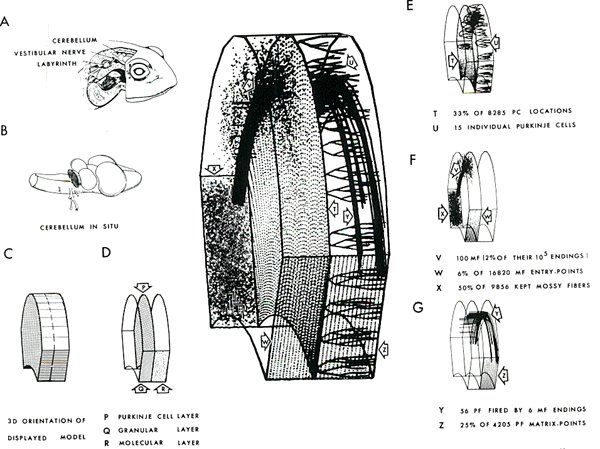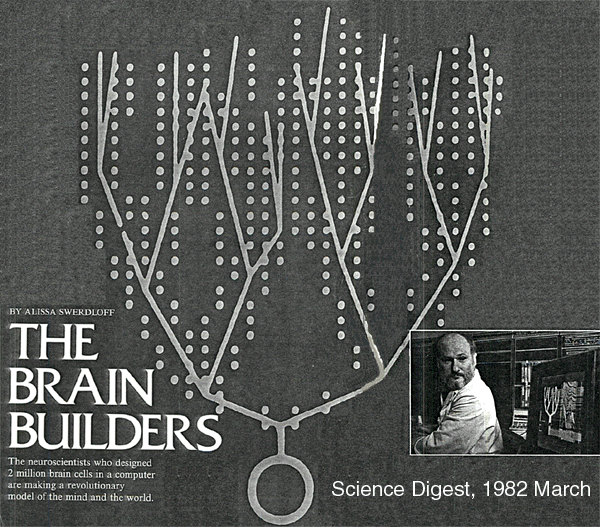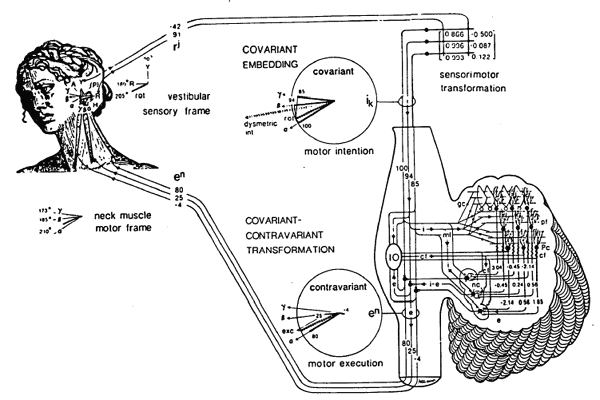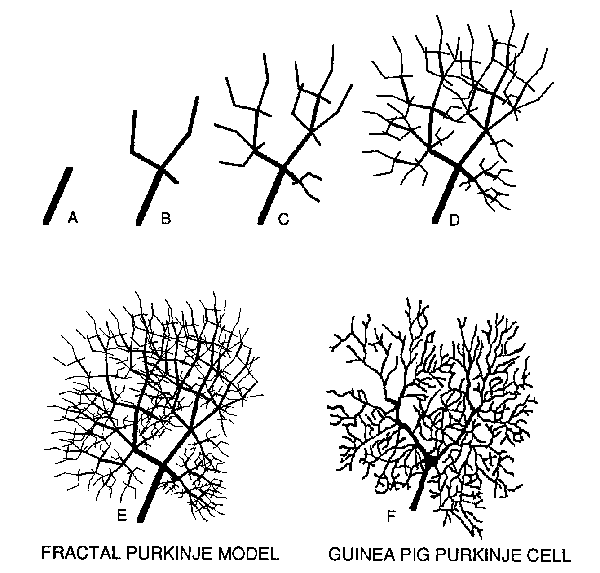
Fig. 3. Pellionisz et al, (1977) Neurocience, 2:19-35. A Computer model of the cerebellar cortex of the frog.
Morphogenesis of the Central Nervous System:
A Third of a Century (1968-2002) to Reveal the Morpho-Genesis of the Brain
András Pellionisz, Ph.D.
Founder of HelixoMetry, Inc.,
Sunnyvale, CA 94086
2002
Pellionisz, 1968, first described large arrays of brain cells from an Information Geometry viewpoint ("Transfer Function of a Geometrical Neuropnal Configuration of the Cerebellar Granular Layer"). He first concluded, that structural redundancy of the brain may serve the role of error supression. Pellionisz started his career with Prof. John Szentágothai, in Budapest in 1967.
Pellionisz, 1970, realized that structuro-functional properties of Neural Networks can only be tackled by means of establishing, using the power of computers, the fundamental parameters that govern their genesis and function. Thus, although an electrical engineer (M.S.E.E. of Budapest Technical School for his first degree, embarked on revealing the principles of "building brains" - and he spent altogether 21 years in various University Medical Schools (with Prof. John Szentágothai's Department of Anatomy, as a tenured Chief Scientist and later D.Sc. of the Hungarian National Academy, then in the Department of Biology of Stanford University, led by Prof. Donald Kennedy, and with Prof. Rodolfo Llinás as a professor of former Physiology & Biophysics Department at New York University), and obtained a Ph.D. in Experimental Biology (later, followed by a D.Sc. in Physics). In his 1970 paper (see Fig. 1. here), the cerebellar neural networks were studied by a computer simulation method, applied for the first time
In the USA, Dr. Pellionisz deployed computer power not available in Hungary in the nineteen-sixties. First, as a Stanford University Post-Doctoral Fellow (1973), and later as Professor of New York University, Dr. Pellionisz built a computer model composed of over 2 million neurons. First published with A.P.'s permission in 1976 (Frog Neurobiology, Ed. by R. Llinás and W. Precht, Springer Verlag, pp. 915-920, Figs. 19-24, and later in Pellionisz et al., 1977, # 30-31) (See Fig.2. here)
Fig. 2. Pellionisz and Llinas, 1977. Grip on the Morphogenesis of large arrays of neurons. A computer model, generating 2 million neurons.

Fig. 3. Pellionisz et al, (1977) Neurocience, 2:19-35. A Computer model of the cerebellar cortex of the frog.
Before the "genomic age", this computer model defined those quantitative features that are necessary to generate 2 million neurons in the neural network of the cerebellum. The most characteristic neurons, the Purkinje cells, show a dendritic arborization that was extensively modeled both for its structure, and function (see the latter in Pellionisz and Llinás, 1977, Neuroscience, 2;37-48). This pioneering work was widely acknowledged, e.g. by Science Digest, 1982, see below.

Fig. 3. Science Digest, 1982 March: "The neuroscientists who designed 2 million brain cells in a computer are making a revolutionary model of the mind and the world. ... Eight years ago, a team of brain researchers decided that the best way to explore the function of the body's most complex organ was to try to "grow" a portion of a brain in a computer. That experiment, and the novel theory of the brain function it spawned, may revolutionize neuroscience as thoroughly as the theory of relativity theory revolutionized physics.
Indeed, by "building" 2 million brain cells, the function of the cerebellum (the so-called "little brain") was revealed.
Pellionisz et al. published from 1979 in scores of papers and books Tensor Network Theory (with it most important publication "Tensor Network Theory of the Metaorganization of Functional Geometries in the Central Nervous System" . This was full-blown Information Geometry, applied to the part of the brain with a role to fit CNS function into the 4-dimensional space-time geometry for motor coordination. While the structural and functional geometry of the CNS was already proven to go beyond the boundaries of Euclidean geometry, to interface brain geometry with external space-time coordination in the Minkowski-space the CNS developed the cerebellar neural networks, acting as a space-time metric tensor.

Fig. 4. Encyclopaedia of Neuroscience: Tensor Network Theory explaining 1/4th of the brain, the cerebellum, as a space-time coordinator. Cerebellar Purkinje neurons comprise the metric tensor.
This work was published (see list of publications) and Patented (US patent 4,450,530) and is now in Encyclopaedia of Neuroscience. The geometrical approach was compared at length with other brain theories (e.g. by Francis Crick) by Prof. Churchland (1985). The accomplishment was awarded the Alexander von Humboldt Prize for Distinguished American Scientists by Germany (1990).
Pellionisz, 1989, started another decade, both by making industrial use of neural net accomplishments with NASA to elaborate a plan (to fly an F15, implemented almost with a decade of delay) and also for genome R&D at NASA Ames Research Center (thus far not materialized, because of wasting significant tax dollars by a decade of an incompetent and unqualified "Biocomputation Center" directress, now in retirement).

Fig. 5. (From Pellionisz, 1989). Inventor of Fractals, Benoit Madelbrot, suspected that brain cells, specifically the Purkinje cells of the cerebellum, could be fractal-like (1976). Taking on this challenge, Pellionisz, 1989 published the first brain cell that was developed based entirely upon a fractal algorithm. The impetus is not only in the obviously self-similar character of these neurons, but also because (having constructed a computer model of 2 million brain cells) Pellionisz had first hand knowledge on the fact that there is simply not enough information in the genome to specify each and every branchlet of the 10 to the power of 11 Purkinje cells in the cerebellum. Thus, some kind of "compression algorithm" must be used by Nature. The paper in 1989 was a demonstration that, indeed, fractal sets could provide the clues for morphogenesis.
Chapter 3.1.3. of the Pellionisz, 1989 paper is entitled "Neural Growth: Structural Manifestation of Repeated Access to Genetic Code". The paper established: "One of the most basic, but in all likelihood rather remote, implication of the emerging fractal neural modeling is that it corroborates a spatial "code repetition" of the growth process with the repetitive access to genetic code. This conceptual link between the two meta-geometries of double helix and "fractal seed" may ultimately lead to precisely pinpinting those exact differences in the "genetic code" that lead to a differentiation to Purkinje-, pyramidal cell, Golgi -cell or other type of specific neurons. It must be emphasized, however, that establishing a rigorous relation of these "code sequences" to the genetic code that underlies the morphogenesis of differentiated neurons may be far into the future... [written in 1989...]
This "far into the future" era had arrived with the human genome published a mere one year ago...
Present invention (patents under submission) directly relate the 4 generations of repeated, self-similar fractal templates to the repetitious, almost identical (fuzzy) repetitions found in the genetic code. Together with the fact, that Magegna (1994) and others have found striking similarities between Natural Languages and the "sequence of letters" of the genetic code, Pellionisz coined "FractoGene" as the "mother of all languages" that spells out growth in the CNS (and other parts of the body, see "visual gallery"):

Fig. 6. FractoGene, with the repeated sequences of the genome spelling out repetitious fractal templates of e.g. a 4-generation Purkinje cell.
With over 1/3 of a Century of labor and Intellectual Property, it is HelixoMetry's business to translate FractoGene (either with established Translation Memory Software Houses, or without, directly with Big Pharma), for Drug Discovery Algorithms that will beat even the "brute force" approach of IBM's "Blue Gene".
For Partnership with Helixometry, please contact
Andras J. Pellionisz, Ph.D., D.Sci, M.S.E.E
Founder and CEO of Helixometry, Inc.
408.891.7187
cob@helixometry.com